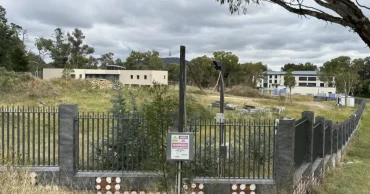Australia
Australia becomes first country to legalise medical psychedelics
Australia is now the first country to allow psychiatrists to prescribe certain psychedelic substances to patients with depression or post-traumatic stress disorder.
Beginning Saturday, Australian physicians can prescribe doses of MDMA, also known as ecstasy, for PTSD. Psilocybin, the psychoactive ingredient in psychedelic mushrooms, can be given to people who have hard-to-treat depression. The country put the two drugs on the list of approved medicines by the Therapeutic Goods Administration.
Scientists in Australia were surprised by the move, which was announced in February but took effect July 1. One scientist said it puts Australia "at the forefront of research in this field."
Chris Langmead, deputy director of the Neuromedicines Discovery Centre at the Monash Institute of Pharmaceutical Sciences, said there have been very few advancements on treatment of persistent mental health issues in the last 50 years.
After years of waiting, medical marijuana sold in Louisiana
The growing cultural acceptance has led two U.S. states to approve measures for their use: Oregon was the first to legalize the adult use of psilocybin, and Colorado's voters decriminalized psilocybin in 2022. Days ago, President Joe Biden's youngest brother said in a radio interview that the president has been "very open-minded" in conversations the two have had about the benefits of psychedelics as a form of medical treatment.
The U.S. Food and Drug Administration designated psilocybin as a "breakthrough therapy" in 2018, a label that's designed to speed the development and review of drugs to treat a serious condition. Psychedelics researchers have benefited from federal grants, including Johns Hopkins, and the FDA released draft guidance late last month for researchers designing clinical trials testing psychedelic drugs as potential treatments for a variety of medical conditions.
New Zealand law to make medical marijuana widely available
Still, the American Psychiatric Association has not endorsed the use of psychedelics in treatment, noting the FDA has yet to offer a final determination.
And medical experts in the U.S. and elsewhere, Australia included, have cautioned that more research is needed on the drugs' efficacy and the extent of the risks of psychedelics, which can cause hallucinations.
US growing largest crop of marijuana for research in 5 years
"There are concerns that evidence remains inadequate and moving to clinical service is premature; that incompetent or poorly equipped clinicians could flood the space; that treatment will be unaffordable for most; that formal oversight of training, treatment, and patient outcomes will be minimal or ill-informed," said Dr. Paul Liknaitzky, head of Monash University's Clinical Psychedelic Lab.
Canada now world's largest legal marijuana marketplace
Plus, the drugs will be expensive in Australia — about $10,000 (roughly $6,600 U.S. dollars) per patient for treatment.
Uruguay is betting on exports of medical marijuana
Litnaitzky said the opportunity for Australians to access the drugs for specific conditions is unique.
"There's excitement about drug policy progress," he said, "... about the prospect of being able to offer patients more suitable and tailored treatment without the constraints imposed by clinical trials and rigid protocols."
Thailand approves medical marijuana
2 years ago
Australia’s High Court dismisses Russia’s bid for injunction to stop its embassy’s eviction
Australia’s highest court on Monday dismissed Russia’s application for an injunction that would have prevented Moscow's embassy being evicted from a site in the national capital Canberra.
In dismissing the application, High Court Justice Jayne Jagot described Russia’s challenge on constitutional grounds to a law terminating the lease as “weak” and “difficult to understand.”
Parliament passed emergency legislation on June 15 that terminated Russia’s lease on the largely empty block on security grounds because the new embassy would have been too close to Parliament House.
Read: With Russia revolt over, mercenaries' future and direction of Ukraine war remain uncertain
Russia’s lawyer Elliot Hyde had argued that the Ambassador Alexey Pavlovsky would not have confidence in the integrity and security of a consular building already on the site if the embassy was not allowed to maintain possession until the challenge to the validity of the lease termination was decided.
Elliot said a man who has been living on the site in a portable cabin at least since last week was a security guard protecting the compound. The man had been described in the media as a Russian diplomat.
Read: When wealthy adventurers take huge risks, who should foot the bill for rescue attempts?
Prime Minister Anthony Albanese said he welcomed the High Court decision and expected the Russians to leave the site.
"The court has made clear that there is no legal basis for a Russian presence to continue on the site at this time, and we expect the Russian Federation to act in accordance with the court’s ruling," Albanese told reporters.
Read: Taliban leader claims women are provided with a 'comfortable and prosperous life' in Afghanistan
The Russian Embassy did not immediately respond to a request for comment. Previously, Russia had accused Australia of “Russophobic hysteria” for canceling the lease of the site in Canberra's diplomatic quarter where Moscow wanted to build a new embassy. The current Russian Embassy is in the Canberra suburb of Griffith and its operations are unaffected.
2 years ago
Twitter given 28 days to clean up "toxicity and hate" in Australia
Australia’s online safety watchdog has issued a legal notice to Twitter demanding an explanation of what the social media giant is doing to tackle a surge in online hate since Tesla CEO Elon Musk bought the platform.
Australia’s eSafety Commission describes itself as the world’s first government agency dedicated to keeping people safer online. The agency said Thursday that it received more complaints about online hate on Twitter in the past 12 months than any other platform and had received an increasing number of reports of serious online abuse since Musk took over the company in October.
The Australian agency’s boss, eSafety Commissioner Julie Inman Grant, said she sent a notice to the San Francisco-based company Wednesday with 36 detailed questions on how Twitter's policies about hateful conduct are enforced.
If Twitter does not respond with factual and truthful responses to all questions within 28 days, an Australian judge could fine the company up to 700,000 Australian dollars ($476,000) for every day of delay, Inman Grant said.
“The whole idea of the basic online safety expectations is that global companies like Twitter are enforcing their own policies … and that they’ve got people and technology to keep their platforms safe,” Inman Grant said.
“They have a Hateful Conduct policy that says you may not directly attack other people on the basis of race, ethnicity, gender, etc., and I want to know if fundamentally they are enforcing this policy and how effectively they are doing so,” she added.
Twitter did not immediately respond to a request for comment Thursday.
The eSafety notice followed Musk's announcement in November that he was granting “amnesty” for suspended accounts. This led to 62,000 banned or suspended users being reinstated to the platform, including 75 accounts with more than 1 million followers each, eSafety said in a statement.
Twitter’s global workforce had been slashed under Musk from 8,000 employees to 1,500, with trust and safety teams shed. Twitter had removed all public policy staff from Australia.
Inman Grant said Indigenous Australians, disabled people and those who identify as LGBTQ+ experience online hate at double the rate of other Australians.
“A third of all reports into our office of online hate are coming from Twitter. It’s been a huge surge since October '22 when Elon Musk took over," Inman Grant told Australian Broadcasting Corp. "Twitter has always been fiery in terms of discourse, but it’s turned into an absolute bin fire.”
“A lot of the changes to the algorithms have made people feel like you see more toxicity, much more coarse discourse. But without lifting the hood and using these transparency powers, we really don’t know what’s happening and this is where we’re trying to get to the bottom of things,” she added.
Australians are not alone in their increasingly hostile experience with Twitter. American advocacy group GLAAD said last week that all major social media platforms do poorly at protecting LGBTQ+ users from hate speech and harassment. But Twitter was the worst.
In its annual Social Media Safety Index, GLAAD gave Facebook, Instagram, TikTok, YouTube and Twitter low or failing scores, saying the platforms don’t do enough to keep their users safe. That said, most improved from a year ago.
Twitter was the only exception. GLAAD’s scorecard called it “the most dangerous platform for LGBTQ people” and the only one that saw its scores decline from last year — to 33% from 45% a year ago.
British rights group Center for Countering Digital Hate found instances of racial slurs on Twitter soared immediately after Musk bought the company.
A racial epithet used to attack Black people was found more than 26,000 times in the week following Musk’s takeover — three times the average for 2022, the center found.
The center also found users who pay for a Twitter Blue Check seemed to enjoy a level of impunity from the platform’s rules on online hate.
Inman Grant chairs the Global Online Safety Regulators Network, which was formed with British, Irish and Fijian online harms regulators in November to coordinate on online safety issues. Each of the 27 European Union states will soon have its own online harms regulator.
Inman Grant said Australia was discussing with other national regulators sharing information and how they might take joint regulatory actions.
“We will be working with other governments to make sure that we’re shining a spotlight on these companies and getting them to improve their standards in doing the right thing,” she said.
2 years ago
Bus carrying wedding guests in Australian wine region rolls over, killing 10 and injuring 25
A bus carrying wedding guests rolled over on a foggy night in Australia's wine country, killing 10 people and injuring 25, police said Monday.
The 58-year-old driver was arrested and being held at a Cessnock police station and will be charged, Police Assistant Commissioner Tracy Chapman said. She would not detail the allegations, including whether speed was a factor, but told reporters “there is sufficient information ... for us to establish that there will be charges.”
The crash happened just after 11:30 p.m. in foggy conditions at a roundabout on Wine Country Drive in the town of Greta in the Hunter Valley region of New South Wales state north of Sydney.
The guests had earlier attended a wedding at the Wandin Estate Winery and were heading for their accommodation in the town of Singleton, Chapman said. One guest told Seven News it had been a nice day and a fairytale wedding.
Read: As India grieves train crash that killed 275, relatives wait for bodies of loved ones
The 25 people injured were taken to hospitals by helicopter and by road. A further 18 passengers were uninjured.
Prime Minister Anthony Albanese thanked first responders and offered government support to victims and their families, saying the “mental scars of this will not go away.”
“For a joyous day like that, in a beautiful place, to end with such terrible loss of life and injury is so cruel and so sad and so unfair,” Albanese told reporters.
“People hire a bus for weddings in order to keep their guests safe. And that just adds to the unimaginable nature of this tragedy,” Albanese added.
Read: India train accident: 2 Bangladeshis receiving treatment in hospital, says deputy high commissioner
Jay Suvaal, the mayor of Cessnock, said the crash was “truly horrific.”
“We are a major wedding and tourist destination in the Hunter Valley, and so there will be people from all over the state and the country that have been to these areas and have probably done similar things," he said. “I think it will send shock waves right through the broader community.”
Greta is in the heart of the Hunter Valley wine region, a picturesque area dotted with vineyards and restaurants. It was the first wine region established in Australia.
The wedding was in the middle of a long weekend, with Monday a public holiday across most Australian states.
Read more: Indian officials end rescue work for 2 wrecked passenger trains that killed over 300 people
2 years ago
New Zealand airline is asking passengers to weigh in before their flights
New Zealand's national airline is asking passengers to step on the scales before they board international flights.
Air New Zealand says it wants to weigh 10,000 passengers during a monthlong survey so pilots can better know the weight and balance of their planes before takeoff.
But the numbers from the scales won't be flashing up for all to see. There will be no visible display anywhere, the airline promised, and the weigh-in data will remain anonymous even to airline staff.
“We weigh everything that goes on the aircraft — from the cargo to the meals onboard, to the luggage in the hold," said Alastair James, a load control improvement specialist for the airline, in a statement. "For customers, crew and cabin bags, we use average weights, which we get from doing this survey.”
Indeed the numbers are required by the nation's industry watchdog, the Civil Aviation Authority.
Under the authority's rules, airlines have various options to estimate passenger weight. One option is to periodically carry out surveys like Air New Zealand is doing to establish an average weight. Another option is to accept a standard weight set by the authority.
Currently, the authority's designated weight for people 13 and over is 86 kilograms (190 pounds), which includes carry-on luggage. The authority last changed the average passenger weight in 2004, increasing it from 77 kilograms (170 pounds).
Health statistics show New Zealanders are becoming heavier. The latest national health survey put the adult obesity rate at 34%, up from 31% a year earlier. Childhood obesity rates increased to 13%, up from 10% a year earlier.
Customers on Air New Zealand domestic flights were asked to weigh in a couple of years ago.
James said there was nothing for passengers to fear by stepping on the scales.
“It’s simple, it’s voluntary, and by weighing in, you’ll be helping us to fly you safely and efficiently, every time," he said.
The airline said the survey began this week and will run through July 2.
2 years ago
Australian Parliament takes step toward holding a referendum on Indigenous Voice this year
Australia's House of Representatives voted overwhelming Wednesday for a referendum to be held this year on creating an Indigenous Voice to Parliament, an advocate aiming to give the nation's most disadvantaged ethnic minority more say on government policy.
While the Voice would advocate for Indigenous interests, it would not have a vote on laws, and debate for and against the elected body has become increasingly heated and divisive.
The 121-to-25 House vote that approved the referendum being held does not reflect the level of lawmakers' support for enshrining the Voice in the constitution. The opposition conservative Liberal Party voted in support of giving Australians a choice at a referendum but is also campaigning for the Voice to be rejected by the public.
Also read: Australian lawmaker breaks ranks to support Indigenous Voice
The Senate will vote on the bill in June, and the bill needs majority support to ensure that Australia's first referendum since 1999 takes place between October and December this year. A majority of senators have already flagged their support.
Minister for Indigenous Australians Linda Burney, the first Indigenous woman to hold the role, said the campaigning would begin in earnest with a successful Senate vote. She had "no doubt" the referendum would succeed.
"A yes vote at a referendum ... will move Australia forward for everyone. It will be a new chapter in our country's story," Burney told reporters.
Also Read: Australian opposition against Indigenous Voice in Parliament
"And a yes vote will make a practical difference — I cannot stress that enough — the Voice will make a practical difference. Because the solutions to so many of our challenges can be found in the knowledge and the wisdom of local (Indigenous) communities," Burney added.
Proponents hope the Voice will improve living standards for Indigenous Australians, who account for 3.2% of Australia's population and are the most nation's most disadvantaged ethnic group.
Australia's Race Discrimination Commissioner Chin Tan, a racism law watchdog, has warned that focusing the public debate on race emboldens racists and exposes the Indigenous population to abuse and vilification.
The Liberal Party and the Nationals party, which formed a conservative coalition government for nine years until elections a years ago, argue the Voice would create a racial divide.
Opposition leader Peter Dutton has told Parliament the proposal would permanently divide Australians by race. "It will have an Orwellian effect where all Australians are equal, but some Australians are more equal than others," Dutton said.
Prime Minister Anthony Albanese, who committed his center-left Labor Party government on election night last year to holding the referendum, said "scare campaigns" against the Voice would not find traction among most Australians.
"Australians won't succumb to their appeals to fear and their ever-more ludicrous invitations to jump at our own shadows," Albanese said in a recent speech.
Speaking in support of the Voice, government minister Tim Watts urged his fellow lawmakers to address Australia's history of refusing to recognize or listen to its Indigenous people.
Watts quoted his own ancestor as a cautionary example: John Watts, a 19th century colonial lawmaker who had justified state-condoned extrajudicial police shootings of Indigenous Outback tribes.
"The natives must be taught to feel the mastery of the whites," John Watts had told the Queensland state Parliament in 1861.
"The natives, knowing no law, nor entertaining any fears but those of the carbine (rifle): there were no other means of ruling them," John Watts had added.
His descendant, Tim Watts, urged lawmakers in Parliament to: "Take this moment to be good ancestors."
Opinion polls show the Voice has majority public support. But many observers say support is not yet high enough to indicate a successful referendum.
Of the 44 referendums held since the constitution took effect in 1901, only eight have been carried and none since 1977.
No referendum has ever been passed without the bipartisan support the major political parties.
The Voice was recommended in 2017 by a group of 250 Indigenous leaders who met at Uluru, a landmark sandstone rock in central Australia that is a scared site to traditional owners. They were delegates of the First Nations National Constitutional Convention that the then-government had asked for advice on how the Indigenous population could be acknowledged in the constitution.
The conservative government immediately rejected the prospect of the Voice, which it likened to a third chamber of Parliament.
2 years ago
China asks Australia to increase search for 39 aboard capsized boat as 2 bodies reportedly found
A Chinese envoy asked Australian authorities on Thursday to increase efforts to find survivors in the search for 39 crew members who were aboard a Chinese fishing boat that capsized in the Indian Ocean, as Chinese media reported two bodies had been recovered.
“We wish that they could send more — more aircraft, more ships and more staff,” Ambassador to Australia Xiao Qian told reporters. “We wish that our Australian colleagues would coordinate with other international or foreign vessels or ships near that area … to help the search and rescue to save as many lives as possible.”
Xiao said China wanted to coordinate with “friendly countries,” including Australia, Indonesia, Sri Lanka and the Maldives, in the search and rescue effort.
The search coordinator, the Australian Maritime Safety Authority, said three aircraft and seven ships including three Chinese navy ships were involved in the search in the center of the Indian Ocean on Thursday. A Sri Lankan navy ship was also heading for the scene, the authority said in a statement.
Two days after the capsize of the Lu Peng Yuan Yu 028, the authority “remains hopeful for a successful outcome, however the time elapsed combined with the weather conditions experienced make survival more challenging,” it said.
Two bodies were pulled from the ocean on Thursday afternoon by the Chinese navy, China’s official Xinhua News Agency reported. No survivors or life rafts have been spotted.
The upturned hull was spotted Tuesday from a cargo ship 5,000 kilometers (3,100 miles) northwest of the Australian west coast city of Perth, the Australian search coordinator said.
Chinese authorities say the missing crew includes 17 from China, 17 from Indonesia and five from the Philippines.
India, whose ties with China have been strained by a deadly border dispute, said it sent reconnaissance planes to help in the search.
The aircraft "have carried out multiple and extensive searches despite adverse weather and located multiple objects possibly belonging to the sunken vessel,” navy spokesman Commander Vivek Mehul said in a statement.
On Wednesday, Chinese President Xi Jinping and Prime Minister Li Qiang ordered Chinese diplomats, as well as the agriculture and transportation ministries, to assist in the search for survivors.
The search authority said the multinational search effort continued Thursday over an area of 12,000 square kilometers (4,600 square miles) south of where the upturned hull was found.
Chinese Foreign Ministry spokesperson Wang Wenbin said Chinese and international agencies remained positive about the search and rescue operation.
“The Chinese government expressed its sincere gratitude and high appreciation. The relevant search and rescue operations are still ongoing.” Wang said at a daily briefing in Beijing.
The capsized boat was based in the eastern coastal province of Shandong and operated by Penglai Jinglu Fishery Co. Ltd.
Another Chinese vessel, Lu Peng Yuan Yu 018, had been operating near the upturned hull and continued to search on Thursday, the Australian authority said.
2 years ago
Fire at New Zealand hostel kills at least 6 people, prime minister says
A fire ripped through a hostel in New Zealand’s capital overnight, killing at least six people and forcing others to flee the four-story building in their pajamas in what a fire chief on Tuesday called his “worst nightmare.”
Fifty-two people had made it out of the building but firefighters were still trying to account for others, Wellington fire chief Nick Pyatt said.
Loafers Lodge resident Tala Sili told news outlet RNZ that he saw smoke pouring through under his door and opened it find the hallway pitch black.
“I was on the top floor and I couldn’t go through the hallway because there was just too much smoke, so I jumped out the window," Sili said.
He said he fell onto a roof two floors below.
“It was just scary, it was really scary, but I knew I had to jump out the window or just burn inside the building," Sili told RNZ.
He said he was rescued from the roof by paramedics and treated for a sprained ankle.
The Loafers Lodge offered basic, affordable rooms with shared lounges, kitchens and laundry facilities to people of a wide range of ages. Some were placed there by government agencies and were considered vulnerable because they had little in the way of resources or support networks.
The hostel is in an industrial area and features billboards on one side. Dark smoke stains extended up the exterior walls on the top story of the building.
Pyatt said firefighters were called to the hostel at about 12:30 a.m. Emergency officials said the building had no fire sprinklers, which Prime Minister Chris Hipkins said was not required in New Zealand’s building code for older buildings that would have to be retrofitted.
Police said the cause of the fire was not immediately known.
Residents told reporters that fire alarms would regularly sound in the building, possibly from people smoking or overly sensitive smoke monitors, so many had initially thought it was another false alarm.
Hipkins said the building was not currently safe for police to enter and it could take authorities some time to confirm the number of dead. He told the AM morning news program that he understood six people were dead and the number of fatalities would likely rise. Police said they did not have an exact count, although they believed the death toll was less than 10.
“It is an absolute tragedy. It is a horrific situation,” the prime minister told reporters. “In the fullness of time, of course, there will be a number of investigations about what has happened and why it happened. But for now, the focus clearly has to be on dealing with the situation.”
Health authorities said two people who had been in the building were being treated at hospitals and both were in a stable condition. Three others had been treated and discharged, while a sixth patient had chosen to leave before getting treatment.
Pyatt, the fire chief, said his thoughts were with the families of those who had perished and with the crews who had rescued those they could and tried to rescue those they couldn’t.
“This is our worst nightmare," Pyatt said. “It doesn’t get worse than this.”
Wellington City Council spokesman Richard MacLean said city and government officials were helping about 50 people who escaped the fire and were at an emergency center the council set up at a running track that had showers and other facilities.
He said a number of elderly people had escaped the building with only the pajamas they were wearing.
“A lot are clearly shaken and bewildered about what happened,” he said.
Loafers Lodge is near Wellington Regional Hospital and has 92 rooms.
The hostel provided a combination of short-term and long-term rentals, MacLean said. He didn't have all the details, he said, but he believed it was used by various government agencies to provide clients with needed accommodation.
Australian Prime Minister Anthony Albanese told reporters he'd spoken with Hipkins and offered Australian assistance.
“This is a dreadful human tragedy," Albanese said. “I expressed my condolences on behalf of Australia to our friends in New Zealand at this very difficult time.”
2 years ago
Sudan's army and rival extend truce, despite ongoing clashes
Sudan's army and its rival paramilitary said Sunday they will extend a humanitarian cease-fire a further 72 hours. The decision follows international pressure to allow the safe passage of civilians and aid, but the shaky truce has not so far stopped the clashes.
In statements, both sides accused the other of violations. The agreement has deescalated the fighting in some areas but violence continues to push civilians to flee. Aid groups have also struggled to get badly needed supplies into the country.
The conflict erupted on April 15 between the nation’s army and its paramilitary force, and threatens to thrust Sudan into a raging civil war. The U.N. warned on Sunday that the humanitarian crisis in Sudan was at “a breaking point.”
“The scale and speed of what is unfolding in Sudan is unprecedented,” the UN’s humanitarian chief Martin Griffiths said in as statement.
He said water and food are becoming increasingly hard to find in the country’s cities, especially the capital, Khartoum, and that the lack of basic medical care means many could die of preventable causes. Griffiths said that “massive looting” of aid supplies has hindered efforts to help civilians.
Earlier Sunday, an aircraft carrying eight tons of emergency medical aid landed in Sudan to resupply hospitals devastated by the fighting, according to the International Committee of the Red Cross, which organized the shipment. It arrived as the civilian death toll from the countrywide violence topped 400 and aid groups warned that the humanitarian situation was becoming increasingly dire.
More than two-thirds of hospitals in areas with active fighting are out of service, a national doctors' association has said, citing a shortage of medical supplies, health workers, water and electricity.
The air-lifted supplies, including anesthetics, dressings, sutures and other surgical material, are enough to treat more than 1,000 people wounded in the conflict, the ICRC said. The aircraft took off earlier in the day from Jordan and safely landed in the city of Port Sudan, it said.
“The hope is to get this material to some of the most critically busy hospitals in the capital” of Khartoum and other hot spots, said Patrick Youssef, ICRC’s regional director for Africa.
The Sudan Doctors’ Syndicate, which monitors casualties, said Sunday that over the past two weeks, 425 civilians were killed and 2,091 wounded. The Sudanese Health Ministry on Saturday put the overall death toll, including fighters, at 528, with 4,500 wounded.
Some of the deadliest battles have raged across Khartoum. The fighting pits the army chief, Gen. Abdel Fattah Burhan, against Gen. Mohammed Hamdan Dagalo, the head of a paramilitary group known as the Rapid Support Forces.
The generals, both with powerful foreign backers, were allies in an October 2021 military coup that halted Sudan's fitful transition to democracy, but they have since turned on each other.
Ordinary Sudanese have been caught in the crossfire. Tens of thousands have fled to neighboring countries, including Chad and Egypt, while others remain pinned down with dwindling supplies. Thousands of foreigners have been evacuated in airlifts and land convoys.
On Sunday, fighting continued in different parts of the capital where residents hiding in their homes reported hearing artillery fire. There have been lulls in fighting, but never a fully observed cease-fire, despite repeated attempts by international mediators.
Over the weekend, residents reported that shops were reopening and normalcy gradually returning in some areas of Khartoum as the scale of fighting dwindled after yet another shaky truce. But in other areas, terrified residents reported explosions thundering around them and fighters ransacking houses.
Youssef, the ICRC official, said the agency has been in contact with the top command of both sides to ensure that medical assistance could reach hospitals safely.
“With this news today, we are really hoping that this becomes part of a steady coordination mechanism to allow other flights to come in,” he said.
Youssef said more medical aid was ready to be flown into Khartoum pending necessary clearances and security guarantees.
Sudan’s healthcare system is near collapse with dozens of hospitals out of service. Multiple aid agencies have had to suspend operations and evacuated employees.
On Sunday, a second U.S.-government organized convoy arrived in Port Sudan, said State Department Spokesperson Matthew Miller. He said the U.S. is assisting American citizens and “others who are eligible” to leave for Saudi Arabia where U.S. personnel are located. There were no details on how many people were in the convoy or specific assistance the U.S. provided.
Most of the estimated 16,000 Americans believed to be in Sudan right now are dual U.S.-Sudanese nationals. The Defense Department said in a statement on Saturday it was moving naval assets toward Sudan's coast to support further evacuations.
Meanwhile, Britain has announced that an extra evacuation flight will depart from Port Sudan on Monday, extending what it called the largest evacuation effort of any Western country from Sudan.
The government asked British nationals who wish to leave Sudan to travel to the British Evacuation Handling Centre at Port Sudan International Airport before 12:00 Sudan time. The flight comes after an evacuation operation from Wadi Saeedna near Khartoum, involving 2,122 people on 23 flights.
2 years ago
Melbourne becomes Australia's biggest city, surpassing Sydney
Following a boundary change, Melbourne has surpassed Sydney as Australia's most populated city for the first time since the 19th-century gold rush.
Sydney has proudly maintained the position for over 100 years, reports BBC.
However, as the population in Melbourne's outskirts grows, the city borders have been stretched to cover the Melton region, it said.
According to the most recent government figures, Melbourne has a population of 4,875,400, which is 18,700 higher than Sydney.
Read More: Australian lawmaker breaks ranks to support Indigenous Voice
The Australian Bureau of Statistics defines a city's "significant urban area" as any linked suburb having a population of more than 10,000 persons.
"Until the 2021 census definition, the Sydney significant area had a higher population than Melbourne. However, with the amalgamation of Melton into Melbourne in the latest... classification, Melbourne has more people than Sydney - and has had since 2018,” Andrew Howe of Australian Bureau of Statistics told the Sydney Morning Herald newspaper, which described the redrawn boundary as "a technicality".
Greater regions of a city, according to the Bureau of Statistics, take into consideration its "functional area" and include individuals that routinely socialize, shop, or work inside the city but may live in small towns or rural areas around it, the report also said.
The federal government, on the other hand, anticipated that Greater Melbourne will surpass Greater Sydney in 2031-32.
Read More: Ten journalists visiting Australia for skills, capacity building in mass media
It is not the first time Melbourne has held the title of Australia's largest city.
Melbourne grew rapidly and outnumbered Sydney until 1905 as a result of the late 19th century gold rush, which saw people flock to the state of Victoria.
2 years ago



















